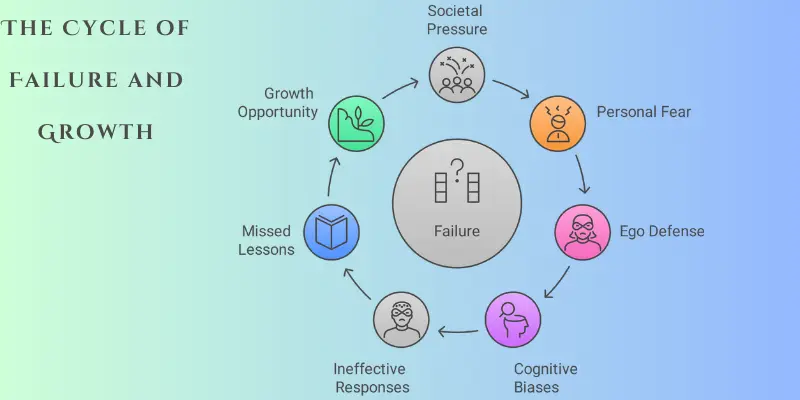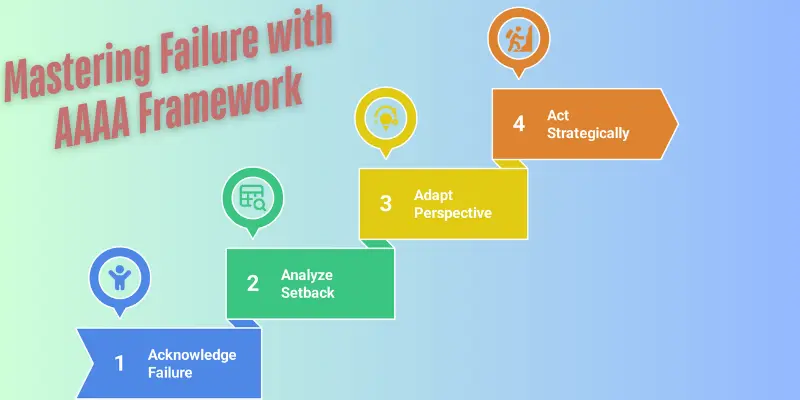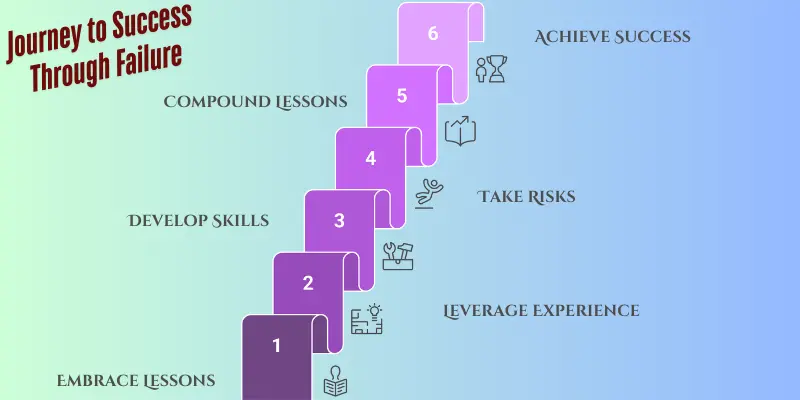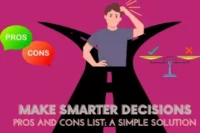What If Failure Is the First Step to Real Success?
Published: 17/05/2025
Everyone fears failure—it’s hardwired into us. But what if the way most people deal with failure is actually holding them back? If you’re struggling with overcoming failure, you’re not alone. The truth is, failure isn’t the enemy—it’s the first step toward real success.
In this post, you’ll discover why how you handle failure matters more than the failure itself, common mistakes to avoid, and a simple framework to help you turn setbacks into growth. Ready to rethink failure and unlock your potential? Let’s get started.
Why We Struggle with Failure: Common Mistakes That Hold Us Back
Failure feels overwhelming for many because of the pressure we face from society and ourselves. Instead of seeing it as a learning opportunity, we often treat failure like a personal flaw or weakness. This mindset traps us in unhelpful patterns that stop growth before it can begin.
The Weight of Stigma: How Society and Fear Make Failure Feel Overwhelming
Failure often feels like a personal and public catastrophe, thanks to the pressure from society and ourselves. We are conditioned to view success as the ultimate goal, and failure is often seen as a reflection of our worth or abilities. This mindset leads us to avoid failure at all costs, often overlooking the valuable lessons it can teach us. Instead of seeing failure as part of the journey, we view it as something to hide or deny, fearing judgment or embarrassment.
- Societal Pressure: Many cultures emphasize success, making failure seem like a personal flaw. This societal stigma can make it harder to embrace failure as a stepping stone to success.
- Personal Fear: On an individual level, the fear of failure can trigger self-doubt and anxiety, preventing us from taking risks or learning from setbacks.

Mental Blocks That Hold Us Back: What Psychology Tells Us
When we fail, our minds don’t always process the experience in a healthy way. Our psychological barriers make it harder to bounce back and learn from failure, leading to avoidance or negative emotions.
Ego at Risk: How Failure Impacts Self-Esteem
Failure can feel like a direct attack on our self-worth. This can trigger a “fight or flight” response, where we either become defensive (fight) or try to avoid facing the failure (flight). Rather than reflecting on the failure objectively, we protect our ego from feeling bruised.
- Defensiveness: Reacting defensively prevents us from learning from mistakes, leading to repeated failures.
- Avoidance: Shying away from failure out of fear can stop us from growing and improving.
Cognitive Biases: Why We Sometimes Downplay What We Can’t Have
Our brains are wired to focus more on negative experiences than positive ones. This leads us to downplay our failures as a defense mechanism. The “sour grapes effect” is when we convince ourselves that we didn’t really want what we failed to achieve, even if that’s not true.
- Negative Processing: Focusing on what went wrong can make it hard to see the potential for improvement.
- Self-Deception: We might tell ourselves that failure wasn’t important, which prevents us from extracting the lessons it offers.
Common Ways We Mishandle Failure
Many of us fail at handling failure because we react in ways that only prolong the pain and stop us from learning. These ineffective responses can prevent growth and keep us stuck in a cycle of frustration.
Denying the Problem or Blaming Others
Instead of accepting responsibility, we often deny the failure or blame others. This prevents us from understanding what went wrong and finding solutions.
- Denial: Refusing to acknowledge the failure prevents any chance for growth.
- Blame: Pointing fingers at others keeps us from recognizing how we can improve.
Overthinking and Harsh Self-Judgment vs. Choosing Self-Forgiveness
Constantly dwelling on past mistakes leads to self-criticism, which only makes things worse. When we focus too much on how we failed, we can’t move forward. Practicing self-forgiveness, on the other hand, allows us to learn from the experience without letting guilt hold us back.
- Rumination: Overthinking the failure creates more negativity and stagnation.
- Self-Forgiveness: Embracing mistakes as opportunities to grow allows us to move on stronger.
Quitting Too Soon vs. Finding the Strength to Try Again
Many people give up after experiencing failure, believing they aren’t capable of succeeding. However, this is often a missed opportunity for growth. The key is to try again, armed with the lessons learned.
- Premature Giving Up: Quitting after one failure means missing out on the chance to improve.
- Perseverance: Repeating the process with new insights leads to eventual success.
Overlooking the Lessons Hidden in Failure
One of the biggest mistakes is failing to learn from failure. If we ignore the lessons failure provides, we’re destined to repeat the same mistakes. It’s essential to pause, reflect, and apply what we’ve learned to the next step.
- Ignoring Lessons: Failing to learn keeps us stuck in the same loop.
- Reflection and Growth: Viewing failure as a teacher helps us grow and move forward.
Mastering Failure: A Simple Framework to Fail the Right Way
Mastering failure isn’t about never falling—it’s about learning how to get back up smarter and stronger each time. With a simple, easy-to-follow framework, you can turn setbacks into stepping stones for real growth.
Introducing the AAAA Framework: A Simple Model to Overcome Failure
Overcoming failure is an art, and to do it effectively, you need a clear, structured approach. The AAAA framework is a simple but powerful model to help you process setbacks, learn from them, and bounce back stronger. It stands for:
- Acknowledge: Accept the reality of the failure.
- Analyze: Understand what happened and why.
- Adapt: Change your perspective and approach.
- Act: Take action with the new insights.
This framework can help you turn failure into a stepping stone rather than an obstacle.

Step 1: Embrace Your Emotions and Accept the Reality
The first step in overcoming failure is acknowledging it—no denial allowed. It’s important to face the reality of the setback, no matter how painful it might be.
- Moving Past Denial: Don’t pretend it didn’t happen or hide from it. Accepting failure is the first step to learning from it.
- Allowing Disappointment: It’s okay to feel bad. Validate your emotions, but don’t let them consume you. Feelings of disappointment are normal and part of the healing process (Greater Good insight).
- Practicing Self-Forgiveness: Counter your inner critic by practicing self-forgiveness. Use pre-prepared phrases like “I’m human, and I can learn from this” to help quiet negative thoughts (Forbes technique).
- Self-Distancing: Try to view the situation from a third-person perspective. This helps you separate your identity from the failure and makes it easier to assess it objectively (Greater Good technique).
Step 2: Reflect Deeply and Learn From Your Setback
Once you’ve acknowledged the failure, it’s time to analyze it carefully. Instead of shifting blame or making excuses, focus on understanding what went wrong and what went right.
- Shifting from Blame to Understanding: Instead of blaming yourself or others, look at what happened with curiosity. What could you have done differently?
- Objective Debrief: Take time to ask questions like: What went wrong? What went right? What were the contributing factors?
- Extracting Lessons: Think about what skills or knowledge you need to develop to avoid repeating the same mistakes. Every failure teaches you something new (Forbes – focus on learning).
- Finding the Informational Value: Failure provides valuable insights that success often doesn’t. Recognize that mistakes give you real, actionable data (Greater Good insight).
- Observing Others’ Failures: Learn from others’ setbacks too. Observing how others handle failure can give you new strategies to apply (Greater Good technique).
After analyzing the failure, it’s time to reframe the situation. Shift your perspective and use failure as feedback instead of a setback.
- Changing Perspective: See failure as a form of feedback, not as the end of the road. It’s a redirection that shows you a new path (Greater Good insight).
- Building Resilience: Reflect on past successes to remind yourself that you’ve overcome challenges before. Building resilience means trusting that you can rise from this (Greater Good insight).
- Reframing the Narrative: Turn the story of failure into a story of growth. Share it with others as a part of your personal journey (Greater Good technique).
- Focusing on the Learning Goal: Instead of focusing only on the outcome, shift your focus to the process of learning and growing. The lessons are more important than the result.
Failure is not the opposite of success—it’s the tuition you pay to earn it.Dr. Carol Dweck, Stanford psychologist and author of Mindset: The New Psychology of Success
Step 3: Change Your Perspective and Shape a Growth Mindset
Changing how you see failure can make all the difference. Instead of viewing it as a dead-end, try to see failure as useful feedback, valuable information, or even a sign pointing you toward a new direction.
Here’s how to shift your mindset effectively:
- Failure as Feedback: Treat setbacks like data. What is this experience telling you? Use it to adjust your approach rather than taking it personally.
- Building Resilience: Remember past wins. Reflecting on times you succeeded before can help you keep failure in perspective and boost your emotional strength.
- Reframing the Story: Change the way you tell yourself about the failure. See it as a chapter in your growth story, not as a full stop. Sharing these stories can also deepen understanding and connection with others.
- Focus on Learning, Not Just Results: Instead of obsessing over the outcome, concentrate on what you can learn from the experience. This mindset encourages continuous growth and keeps you moving forward.
This shift in thinking helps transform failure from a setback into a powerful tool for personal and professional development.
Step 4: Take Action and Keep Learning Along the Way
Now that you’ve processed the failure, it’s time to take action. Apply what you’ve learned and try again, but do it strategically.
- Trying Again Strategically: Don’t just jump in blindly. Apply the lessons learned from your analysis and tweak your approach (Forbes – try, try again).
- Taking Calculated Risks: Fear of failure can make you avoid taking risks, but this only limits your potential. Use the 30-day rule concept: take calculated risks and see how they work out over time (Forbes technique).
- Incremental Progress: Don’t overwhelm yourself with the idea of “big wins.” Break your next steps into smaller, manageable tasks to build momentum and make progress over time.
Putting Failure into Practice: How to Handle Career Setbacks with Confidence
Career setbacks are tough, but they don’t have to stop you. With the right mindset and approach, you can turn these challenges into stepping stones for new opportunities and growth.
Turning Job Rejections Into Opportunities: How to Learn, Adjust, and Stay Motivated
Rejection during the job search process can feel disheartening, but it’s not the end. Instead of giving up, use the AAAA framework to reframe the experience and grow from it.
- Acknowledge: Accept that rejection is a normal part of the job search process. It doesn’t define your abilities or worth.
- Analyze: Review your applications and interviews to identify what went well and where you could improve. Did you misinterpret the job requirements? Was there a mismatch in communication?
- Adapt: Refine your approach based on the feedback you gather. This might include adjusting your resume, enhancing your interview skills, or researching companies more thoroughly.
- Act: Keep applying, but now with more confidence and a refined strategy. Every rejection is a lesson that brings you closer to success.
A ‘no’ is just a comma in your career story—not a period.Liz Ryan, Founder of Human Workplace
Owning Workplace Mistakes: Communicate, Learn, and Grow Together
Mistakes in the workplace or project failures can be tough, but how you handle them can define your career growth. The key is owning your mistakes and learning from them.
- Acknowledge: Own up to your errors openly. This shows accountability and honesty, which can help build trust with your team.
- Analyze: Reflect on what went wrong—was it a lack of communication, resources, or clarity in goals? Identify the root causes of the failure.
- Adapt: Use what you’ve learned to improve your approach. This might mean setting clearer expectations in future projects or adopting new collaboration tools.
- Act: Apply the lessons learned to your next project. Use the failure as an opportunity to improve team dynamics and your own skill set.
Turning Career Challenges Into Fresh Starts and Growth
Career setbacks like a layoff or stalled promotion can feel like failure, but they often present an opportunity to re-evaluate your goals and take your career in a new direction.
- Acknowledge: Recognize that career setbacks are often out of your control, and it’s okay to feel disappointed. The key is not to stay stuck in that feeling.
- Analyze: Reflect on why the setback happened. Was the company restructuring? Did you miss out on opportunities for growth? Identify factors that may have contributed.
- Adapt: Use this time to re-assess your career goals and passions. You might consider upskilling, exploring new industries, or pivoting to a different role.
- Act: Take the steps needed for a career pivot, whether it’s learning new skills, networking in a different field, or applying for jobs that better align with your updated goals.
By applying the AAAA framework to these common career scenarios, you can transform setbacks into opportunities for learning, growth, and future success.
Beyond Just Bouncing Back: How Failure Becomes the Driving Force for Real Success
Failure isn’t just something to recover from—it’s a powerful force that can push you toward real growth and success. When you learn to use failure as a tool, it opens the door to new strengths and opportunities.

Moving Beyond Just Overcoming Failure to Making It Work for You
Overcoming failure is just the beginning. To truly succeed, you need to shift your mindset from simply bouncing back to actively leveraging the lessons learned.
- Embrace the Lessons: Instead of seeing failure as a roadblock, view it as a tool for growth. Each failure offers insights that help you refine your approach.
- Leverage Experience: Use the knowledge you gain from setbacks to make smarter decisions moving forward and approach challenges with a new perspective.
How Navigating Failure Develops Key Skills Like Resilience and Creativity
When you face setbacks head-on, you don’t just overcome them—you grow stronger. Failure helps you develop essential skills that are crucial for long-term success.
- Resilience: Overcoming failure teaches you how to bounce back from adversity, building emotional strength for future challenges.
- Problem-Solving: Failures often force you to think critically and creatively, sharpening your problem-solving abilities.
- Creativity: Being forced to find new solutions can ignite creative thinking, which is vital for innovation and growth.
- Empathy: Experiencing failure yourself helps you understand others’ struggles, fostering empathy and stronger connections in both personal and professional relationships.
How Taking Risks and Embracing Failure Sparks Breakthroughs
Innovation doesn’t happen without risk. Every new idea or breakthrough comes with the possibility of failure, but that’s part of the process.
- Experimentation: Trying new things and stepping outside your comfort zone is essential for growth. When you experiment, failure is often an inevitable part of the journey.
- Intelligent Failures: The best innovators understand that failure isn’t wasted. They embrace what HBR calls “intelligent failures”—those that provide valuable lessons and help refine the path toward success.
Compounding Lessons: How Repeated Failures Fuel Rapid Growth
Failure isn’t just a single setback—it’s a series of opportunities to grow and improve. When you learn from multiple failures, the lessons compound, leading to exponential growth over time.
- Layered Growth: Each failure builds upon the last, making you more capable, adaptable, and prepared for future challenges.
- Exponential Learning: The more you fail and learn, the faster you grow. Each setback adds a new layer of knowledge, making you increasingly better equipped to handle future obstacles.
Success After Setbacks: Inspiring Stories of Failure and Triumph
The road to success is rarely a straight line. Many well-known success stories involve significant failures that ultimately led to even greater achievements.
- Steve Jobs: Fired from Apple in 1985, Jobs went on to create Pixar and NeXT, which ultimately led to his return to Apple, where he turned the company into one of the world’s most successful businesses.
- J.K. Rowling: Before the success of the Harry Potter series, Rowling faced rejection after rejection from publishers. Her perseverance through failure turned her into one of the best-selling authors of all time.
Embrace Failure to Unlock Your True Potential and Success
In summary, we’ve seen that how we handle failure can make all the difference. Many of us fail at failing by avoiding or mishandling setbacks, but with the right approach, failure becomes a powerful tool for growth. The AAAA framework—Acknowledge, Analyze, Adapt, and Act—offers a structured way to not just recover from failure, but to leverage it for greater learning and long-term success.
Remember, overcoming failure isn’t just about bouncing back. It’s about embracing each setback as a stepping stone that unlocks deeper insights, strengthens your resilience, and fuels your journey toward genuine success. Failure is not a roadblock; it’s a catalyst for growth and innovation.
Now, I challenge you to apply this framework to your own life. The next time you face a setback, pause and ask yourself: How can I Acknowledge, Analyze, Adapt, and Act on this experience to improve and grow? Don’t let failure hold you back—use it as a stepping stone to unlock your full potential.
I’d love to hear about your experiences. How have you turned a failure into a lesson? Share your thoughts in the comments below and let’s continue the conversation!
Your Top Questions About Overcoming Failure—Answered Clearly and Honestly
Understanding the roots of fear can help us address it effectively.
Fear of failure often stems from societal pressures, personal insecurities, and past experiences. It’s a natural response, but recognizing that failure is a part of growth can help in overcoming this fear.
Learning from failure is a skill that can be developed.
Reflect on what went wrong, identify patterns, and apply those lessons to future endeavors. This approach transforms setbacks into stepping stones for success.
Avoiding these pitfalls can lead to better outcomes.
Common mistakes include ignoring the lessons from failure, blaming others, or giving up too soon. Embracing failure as a learning opportunity can prevent these errors.
Resilience is key to bouncing back stronger.
Focus on self-compassion, seek support from others, and maintain a positive outlook. These strategies can help in building mental and emotional strength.
Failure can indicate you’re pushing your boundaries.
Experiencing failure often means you’re stepping out of your comfort zone and trying new things, which is essential for growth and success.
Mindset plays a crucial role in how we perceive failure.
Adopt a growth mindset by viewing challenges as opportunities to learn and improve, rather than obstacles.
Being kind to yourself accelerates recovery.
Self-compassion helps in reducing negative self-talk and promotes a healthier, more constructive response to setbacks.
Career growth often involves learning from mistakes.
Analyze past failures to identify areas for improvement, and use this insight to make informed decisions moving forward.
It’s natural to feel down, but it’s important not to stay there.
Acknowledging your feelings and allowing yourself time to process can lead to a quicker and more effective recovery.
Offering support can make a significant difference.
Listen empathetically, share your own experiences, and encourage them to see failure as a part of the learning process.

- Be Respectful
- Stay Relevant
- Stay Positive
- True Feedback
- Encourage Discussion
- Avoid Spamming
- No Fake News
- Don't Copy-Paste
- No Personal Attacks



- Be Respectful
- Stay Relevant
- Stay Positive
- True Feedback
- Encourage Discussion
- Avoid Spamming
- No Fake News
- Don't Copy-Paste
- No Personal Attacks





